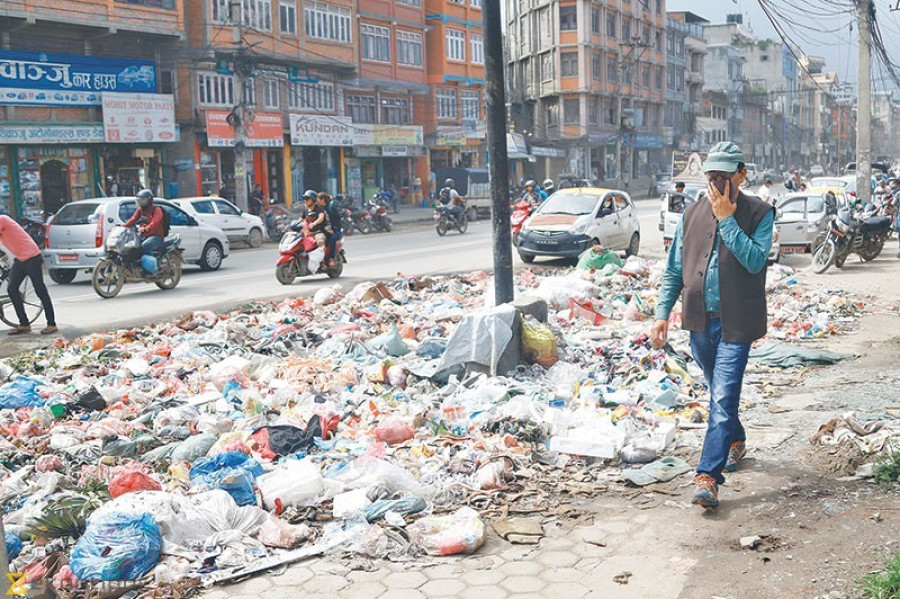Valley
Lack of efficient garbage disposal and management system spells trouble for Valley residents this monsoon
Rains damage the road that leads to Sisdole landfill site obstructing garbage collection from the Valley.
Anup Ojha
Monsoon has arrived and with it the annual problem of overflowing garbage in the metropolis.
Every year, residents of the Kathmandu Valley have to suffer the unbearable stench emanating from garbage littered on the roads as a result of a lack of efficient garbage disposal and management system in the Valley.
This year, the problem threatens to worsen with the 27-km road section that leads to Sisdole landfill site in Nuwakot already damaged by the monsoon showers the Valley witnessed in the past few days.
“The road that leads to Sisdole was asphalted just six months ago. But the monsoon rain has badly damaged the road section in Thulo Khola and Simtar,” said Kedar Paudel, ward-2 Chairperson at Kakani Rural Municipality.
Locals say that the lorries carrying garbage have started to return without dumping the garbage since the road to the top of Sisdole, constructed on piles of garbage, has also started to erode.
Every day the Kathmandu Valley sends 800 metric tonnes of solid waste to Sisdole on 150 lorries, of which the metropolis alone generates 500 metric tonnes. The landfill site reached its capacity to store waste three years ago, but without an alternative the metropolis has been dumping solid waste in the overflowing landfill site at Sisdole. The landfill site, which was a gorge a decade ago, now resembles small hills made of garbage.
Back in 2005, the metropolis had made a commitment to use the Sisdole landfill site, which is spread over 740 ropanis, for three years only but the landfill site continues to be used 13 years later.
After numerous protests from the locals and public criticism, the metropolis identified an alternative dumping site in Banchare Dada (which lies between Nuwakot and Dhading districts, about two kilometres from Sisdole). The construction of this alternate dumping site—spread over 1,792 ropanis—took off on May 5 this year, but it does not offer an immediate solution to the Valley’s waste management problem. An engineer associated with Ministry of Urban Development, Padam Mainali, said, “If nothing obstructs us, we can complete this project in a year.” He however said that the onset of monsoons means that the project might seek for an extension. The project is estimated to cost Rs400 billion.
But locals living near Sisdole are not convinced of the completion of the alternative dumping site in a year’s time since the government officials had made promises to close the dumping site at Sisdole earlier too.
“We don’t believe any claims made by the ministry or from metropolitan office because it’s been a decade since they have been talking about Banchare Dada, but nothing concrete has come out of that plan,” Chandra Bahadur Balami, Rural Municipality-2 Chairperson, told the Post. “We have been deprived of fresh air and good health for over a decade now but the mayor does not care,” said Balami.
In July last year, the Sisdole landfill site reached its capacity forcing KMC to halt garbage collection from the Valley for nearly a month, leaving over four million people of the Valley to suffer.
“When garbage collection came to a halt for a month, people in Kathmandu complained stating that it was difficult for them to breathe, or take a walk outside. People living near Sisdole have to suffer this fate all year around. Has anybody thought about them?” questioned Paudel.
When the Post asked Mayor Bidya Sundar Shakya regarding the waste management issues facing Kathmandu in the light of the overflowing Sisdole landfill site, and about the pace of construction of the alternative dumping site in Banchare Dada, he said, “It is the responsibility of the Urban Development Ministry.” He said that the metropolis is only responsible for managing the waste collected from the metropolis.
Talking to the Post, Environment Division Chief Hari Bahadur Shrestha said that troubled times are ahead for the entire Valley. “It has started to rain now. Our lorries are not being able to reach the landfill site and we have no alternative means to dump them elsewhere,” said Shrestha.
“The metropolis had promised to asphalt each and every household near the dumping site, had promised us free health check ups, but we don’t have any of that,” said Paudel.
Due to the colossal amount of garbage mounting in Sisdole, aside from health risks, the locals complain of drop in their agricultural produce and loss of livestock because of the diseases that the piles of garbage spreads. The whole village—from tea shops on street sides to local eateries in the area—spend their days chasing away flies that may be agents of infectious diseases.
“Almost every household has at least one member infected with some types of disease in this area,” said Kalpana Pandey, health coordinator of Kakani Rural Municipality. “This waste problem has become chronic, and it’s taking a huge toll on the locals here.”




 11.12°C Kathmandu
11.12°C Kathmandu.jpg)









%20(1).jpg&w=300&height=200)

